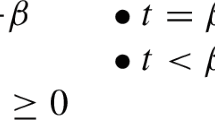Abstract
The crisp literature provides characterizations of the preorders that admit a total preorder extension when some pairwise order comparisons are imposed on the extended relation. It is also known that every preorder is the intersection of a collection of total preorders. In this contribution we generalize both approaches to the fuzzy case. We appeal to a construction for deriving the strict preference and the indifference relations from a weak preference relation, that allows to obtain full characterizations in the conditional extension problem. This improves the performance of the construction via generators studied earlier.
Similar content being viewed by others
Notes
Contrary to our notation, Georgescu calls transitive consistent to those fuzzy relations such that \(R^T\) is a compatible extension of R.
This proof partially replicates the proof of Theorem 2 in Alcantud and Díaz (2015). At the risk of being reiterative, we present all the steps for the sake of completeness. We insist that the formulae used here and in Alcantud and Díaz (2015) to obtain the indifference and strict preference relations are different.
We are very grateful to an anonymous referee for pointing out this stimulating possibility for research.
References
Alcantud, J. C. R. (2009). Conditional ordering extensions. Economic Theory, 39, 495–503.
Alcantud, J. C. R., & Díaz, S. (2015). Conditional extensions of fuzzy preorders. Fuzzy Sets and Systems, 278, 3–19.
Arrow, K. J. (1963). Social choice and individual values (2nd ed.). New York: John Wiley & Sons.
Belohlavek, R. (2002). Fuzzy relational systems: foundations and principles. Kluwer Academic/Plenum Press (Vol. 20 of IFSR International Series on Systems Science and Engineering), New York.
Bodenhofer, U., & Klawonn, F. (2004). A formal study of linearity axioms for fuzzy orderings. Fuzzy Sets and Systems, 145, 323–354.
Bossert, W. (1999). Intersection quasi-orderings: An alternative proof. Order, 16, 221–225.
Dasgupta, M., & Deb, R. (2001). Factoring fuzzy transitivity. Fuzzy Sets and Systems, 118, 489–502.
De Baets, B., & Fodor, J. (2003). Additive fuzzy preference structures: the next generation. In B. De Baets & J. Fodor (Eds.), Principles of fuzzy preference modelling and decision making (pp. 15–25). Ghent: Academia Press.
Díaz, S., De Baets, B., & Montes, S. (2008). On the compositional characterization of complete fuzzy pre-orders. Fuzzy Sets and Systems, 159, 2221–2239.
Díaz, S., De Baets, B., & Montes, S. (2010). General results on the decomposition of transitive fuzzy relations. Fuzzy Optimization and Decision Making, 9, 1–29.
Donaldson, D., & Weymark, J. A. (1998). A quasiordering is the intersection of orderings. Journal of Economic Theory, 78, 382–387.
Dushnik, B., & Miller, E. W. (1941). Partially ordered sets. American Journal of Mathematics, 63, 600–610.
Georgescu, I. (2008). Compatible extensions and consistent rationalizability: A fuzzy approach. In TUCS Technical Reports 881, Turku Centre for Computer Science.
Georgescu, I. (2003). Compatible extensions of fuzzy relations. Journal of Systems Science and Systems Engineering, 12, 332–349.
Georgescu, I. (2007). Fuzzy choice functions: A revealed preference approach. Berlin: Springer.
Georgescu, I. (2008). Fuzzy Szpilrajn theorem through indicators. International Journal of Computers, Communications and Control, III(4), 336–343.
Georgescu, I. (2015). On indicators of fuzzy relations. Annals of Fuzzy Mathematics and Informatics, 9(4), 553–571.
Gottwald, S. (1993). Fuzzy sets and fuzzy logic. Braunschweig: Vieweg.
Hansson, B. (1968). Choice structures and preference relations. Synthese, 18, 443–458.
Höhle, U., & Blanchard, N. (1985). Partial ordering in L-underdeterminate sets. Information Sciences, 35, 133–144.
Szpilrajn, E. (1930). Sur l’éxtension de l’ordre partiel. Fundamenta Mathematicae, 16, 386–389.
Zadeh, L. (1965). Fuzzy sets. Information and Control, 3, 338–353.
Zadeh, L. (1971). Similarity relations and fuzzy orderings. Information Sciences, 3, 177–200.
Acknowledgments
Both authors acknowledge financial support by the Spanish Ministerio de Economía y Competitividad, the first one under Project ECO2015-66797-P, the second one under Project TIN2014-59543-P.
Author information
Authors and Affiliations
Corresponding author
Rights and permissions
About this article
Cite this article
Alcantud, J.C.R., Díaz, S. Fuzzy preorders: conditional extensions, extensions and their representations. Fuzzy Optim Decis Making 15, 371–396 (2016). https://doi.org/10.1007/s10700-016-9230-3
Published:
Issue Date:
DOI: https://doi.org/10.1007/s10700-016-9230-3




